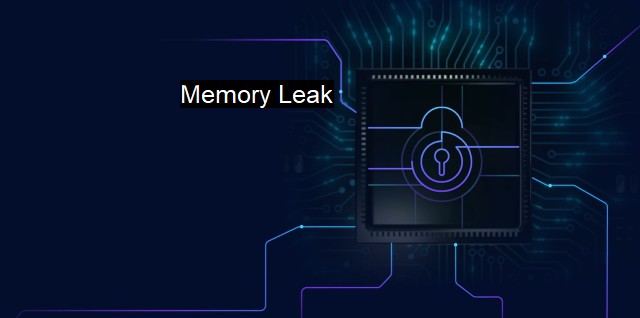What is Memory Leak?
The Consequences of Neglecting Memory Leaks: Understanding Their Impact on Cybersecurity
A memory leak, in the context of computer science and cybersecurity, is a type of unintentional yet persistent increment of computer memory usage, which occurs when a computer program inaccurately manages memory allocations. At its core, it is a software flaw that occurs when a program records data in memory and fails to free the memory when it no longer needs that data. Thus, memory leaks lead to decreased system performance, causing programs to run slower and even crash.Program developers generally bear the responsibility of memory management in various software systems. When used appropriately, developers would create data in their memory and retrieve it when needed. they should eventually remove the data when it has served its purpose - freeing the system memory and making it available for other memory-required applications and services.
The memory leak issue lurks due to a bug in a program’s memory management, which occurs when the application carelessly consumes memory but fails to give it back to the operating system. Even before causing significant problems, regular small memory leaks can create substantial issues over time. If the software program remains in operation for sufficiently long—a scenario typical of servers—the accumulation can affect the system performance seriously.
Now, coming to pivotal cybersecurity and antivirus perspective, this issue is often associated with a potential breach in systems, paving ways for hackers and virus-triggering agents to exploit opportunities. This software vulnerability can create a favorable breeding ground for these cyber threats. A hacker can manipulate the leak to unleash malicious program sequences or virus entities that consume system resources, eventually destabilizing the system.
A good antivirus software should have the ability to find memory leaks and repair them. it can be challenging since memory leak bugs are not necessarily classified as malware or virus, rather as a coding error. An advanced and well-equipped antivirus program, therefore, also carries the ability to rectify coding errors, hence correctly identifying memory leak.
An integrated memory leak detection tool in antivirus concludes any leaked memory leftover by programs even after their operation termination. It can then automatically clean or close such leftover processes. It is critical to understand that while antivirus software can protect systems from most cybersecurity threats, it cannot block or fix memory leaks stemming from bad coding in the program itself. For this reason, coding professionals need to enact preventive measures at the development stage to avoid this issue altogether.
For enhanced cybersecurity, organizations should enforce regular training among those involved in coding and software development procedures. This can instill awareness concerning such underlying programming defects leading to memory leaks and thereby encouraging more robust code writing and review methodologies.
Organizations, as a security best practice, must maintain and regularly update robust antivirus software that can intercept and control any malicious activity resulting from memory leak vulnerabilities. The ability to comprehend, anticipate, and manage memory leaks can provide an effective guard against unwarranted system slowdowns and crashes, ultimately keeping the wayward cybersecurity threats at bay.
To sum up, a memory leak is a coding error that might look benign initially but can escalate into large problems over time, including fostering a privileged environment for cyber threats. While a comprehensive antivirus can help regulate the malfunctions to an extent, the ultimate solution lays in adept coding practices and indulging in proactive measures at the developer-level. Regardless, continuous system checks, upgrading antivirus software, and spreading awareness amidst the coding community can prove instrumental in eliminating the potential risks of memory leaks.

Memory Leak FAQs
What is a memory leak in the context of cybersecurity and antivirus?
In cybersecurity and antivirus context, a memory leak occurs when a program or process uses memory but fails to release it. As a result, the system runs out of memory, leading to crashes, slow performance, and security vulnerabilities.What causes memory leaks in antivirus software?
Memory leaks in antivirus software can be caused by coding errors, hardware or software malfunctions, third-party software conflicts, or insufficient system resources. In some cases, malware or viruses can deliberately trigger memory leaks to compromise the security of the system.How can memory leaks be detected in antivirus software?
Memory leaks in antivirus software can be detected through performance monitoring tools that track the use of system memory by different processes and applications. Other indicators of memory leaks include crashes, freezes, and abnormal system behavior. Antivirus developers also conduct rigorous testing to identify and fix memory leaks before releasing new versions of their software.What are the risks of memory leaks in antivirus software?
Memory leaks in antivirus software pose a significant security risk as they can allow attackers to exploit vulnerabilities in the system and execute malicious code. Memory leaks can also cause system crashes, data loss, and other performance issues that can further compromise the security of the system. As such, users should always ensure that their antivirus software is up-to-date and that any memory leak issues are promptly reported and resolved.| | A | | | B | | | C | | | D | | | E | | | F | | | G | | | H | | | I | | | J | | | K | | | L | | | M | |
| | N | | | O | | | P | | | Q | | | R | | | S | | | T | | | U | | | V | | | W | | | X | | | Y | | | Z | |
| | 1 | | | 2 | | | 3 | | | 4 | | | 7 | | | 8 | | |||||||